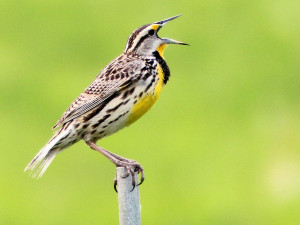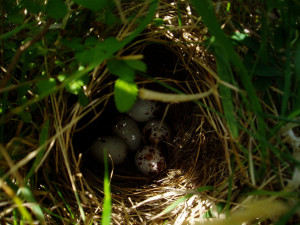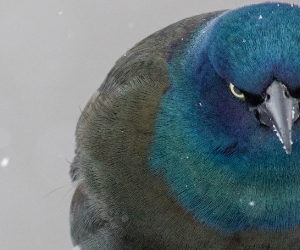Species Spotlight: Eastern Meadowlark
Get to know some of the species at risk in the Lac Deschênes IBA with the Species Spotlight, aka “Sp-Spot”. Today meet the: Eastern Meadowlark

Photo by Kenneth Cole Schneider
Scientific Name: Sturnella magna
SARA Status: No Status; Ontario: Threatened
Taxonomic group: Birds
Size: 19- 26 cm size, with a wingspan of 35-40 cm, and weighing 90-150 g
The Eastern Meadowlark is a medium-size songbird, with a short tail and a long, slender bill. They are pale brown on the back with bright yellow throat and belly, and a large black “V” on the chest. There is also a yellow line above the eyes to the bill. Wing and tail feathers are brown with black stripes, and the white outer tail feathers are visible when flying.
Both sexes are similar, but females are smaller and slightly less marked than males.
Eastern Meadowlarks live mainly in native grasslands and prairies, but also in pastures, hay and alfalfa fields, airports, roadsides, golf fields and other open areas. They like to sing flute-like songs from small trees, fence posts and telephone lines. Their unique nests with an overhead roofs and tunnel entrances are build on the ground in grassland habitats. When nesting, males establish a 6 acre territory with he shares with two females, rarely three. Eastern Meadowlarks forage along the ground searching for insects to eat. They also eat seeds and berries.
Eastern Meadowlarks have been declining in much of their range due to land use changes and human disturbance, such as early mowing, livestock overgrazing and use of pesticides. In Ontario, their numbers have declined by almost 65% during the last 40 years.
Where Else Can You See This Species?

Eastern Meadowlark nest and eggs
Photo by Mike Allen
This species is a permanent resident in most of its range and only the northern birds migrate. They usually leave by the end of November and return in May in small to large flocks.
The Eastern Meadowlark has one of the widest distributions of the songbirds, from South America through Central America and into to North America. The northern breeding range includes Minnesota and Michigan, Ontario, Quebec, New Brunswick and Nova Scotia. But it also breeds in the rest of its range.
Locally, you can observe the Eastern Meadowlark in the Deschênes area and along the Ottawa River. This species has also been spotted along the roads and in several agricultural areas.
Did you know?
• Eastern and Western Meadowlarks look very similar, but sound very different. You don’t have to worry about identifying between the two here though as their ranges overlap only in central US.
• Eastern meadowlarks can sing several variations of a song. An analysis of an Eastern Meadowlark vocalizations discovered more than 100 different patterns in the song.
• This is a polytypic species which means that there is a lot of variation in the species. In fact, there are 16 subspecies! Only one of these subspecies is found in Canada, the Sturnella magna magna.
Check back every week to read about a different species at risk that can be found in Lac Deschênes.
You can report sightings of this and other rare species to the Canadian Wildlife Service at (819) 997-2800 or onthe MNR Natural Heritage Information Centre website. A photo and a location are very helpful!
We would like to thank our guest blogger Monica Reyes for this post. Monica is a conservation volunteer for Nature Canada. She is a biologist from Mexico interested in wildlife conservation and environmental education.




